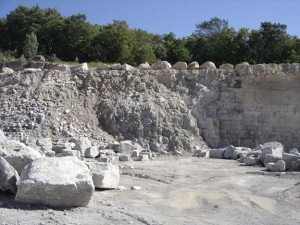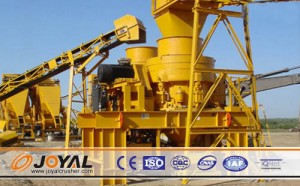

 Limestone Basics
Limestone Basics
Limestone is a sedimentary rock composed largely of the mineral calcite (calcium carbonate: CaCO3). Like most other sedimentary rocks, limestones are composed of grains; however, most grains in limestone are skeletal fragments of marine organisms such as coral or foraminifera. Other carbonate grains comprising limestones are ooids, peloids, intraclasts, and extraclasts. Some limestones do not consist of grains at all and are formed completely by the chemical precipitation of calcite or aragonite. i.e. travertine.
We can supply limestone crushing plant by the capacity of 50-500 tons per day. Limestone production flow mainly include: limestone crushing and transportion, raw material pre-homogenizing, raw material preparation, raw material homogenizing, warm-up decomposition, sintering clinker stone crusher, limestone grinding, limestone packaging and so on.
The design of a stone crushing production line is usually decided by several factors:
1) Raw materials to be crushed
2) The hardness, percentage of Si, moisture percentage of the raw materials
3) The average size of the raw materials before entering into the crushing system
4) Requested product sizes, percentage of the sizes, and their usage
5) Hour capacity of the crushing line
Proposal
For the Limestone crushing production lines: 30-50tph, 50-80tph, 80-120tph, 120-200tph, 200-300tph, 300-400tph, and 400-500tph, we here recommend three proposals:
Proposal 1: vibrating feeder + primary Jaw crusher + impact crusher + Vibrating screen + belt conveying system + control system
Proposal 2: vibrating feeder + primary Jaw crusher + fineness Jaw crusher + impact crusher (optional) + vibrating screen + belt conveying system + control system
Proposal 3: vibrating feeder +primary Jaw crusher + cone crusher + impact crusher (optional) + vibrating screen +belt conveying system + control system
 In the above proposals, the main difference is the secondary crusher: using impact crusher (hammer crushing principle), or using fineness Jaw crusher (plate pressing principle), or Compound cone crusher (plate pressing principle).
In the above proposals, the main difference is the secondary crusher: using impact crusher (hammer crushing principle), or using fineness Jaw crusher (plate pressing principle), or Compound cone crusher (plate pressing principle).
If the local market has not request of the stone shape, users prefer to use fineness Jaw crusher, or Compound cone crusher as the secondary crusher. Because for high hardness stones, the quick wear parts cost of fineness crusher/cone crusher is lower than that of impact crusher. For Jaw crusher and compound cone crusher, the working principle is plate pressing, so the percentage of stones with flaky shape, internal cracks is high. For impact crusher, it has the functions of crushing and shaping, can make very good cubic shape; the stone materials are mainly used for highway, water conservancy, airport, civil construction etc. The market prices of stones made by impact crusher is higher than that by fineness Jaw crusher or compound cone crusher; the quick wear parts cost of impact crusher is also high for high hardness stones.
If the market has request for the stone shape, and the users want to reduce the quick wear parts cost. Here we recommend firstly use primary Jaw crusher + fineness Jaw crusher/compound cone crusher as the primary and secondary crushers, take the impact crusher as the tertiary crusher to shaping the stones. This proposal has been adopted by many users, and proved to be workable.
We warmly welcome you to come to inspect our factory, and we would like to design the most suitable proposal as per your requests.